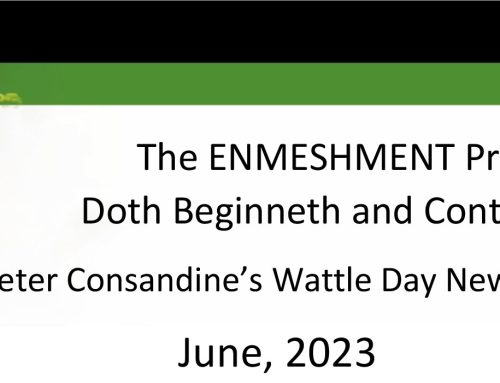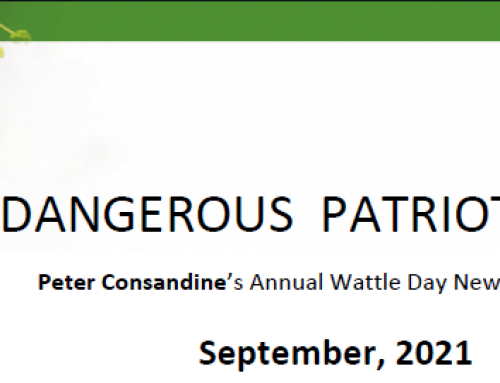Wattle Day Luncheon talk by PETER CONSANDINE on Thursday, 1st September 2011 at Parramatta. PETER, who is the National Executive Director and Founder of The Republican Party of Australia, maintains that the day offers the chance to reflect on who we are as a people and that which is our relationship to the land.
Highways are a necessary part of modern life. Purely functional, sometimes they are so good [as motorways, for example] they are boring – but never at this time of year, when plantings of wattle along many of our major highways turn them into rivers of gold.
When the wattle blooms in August, we know that Winter is nearly done and Spring is in the air. We see that different species grow along our roadways and note that they flower at different times and their blossoms vary in form, shape and intensity of colour. What’s more, we tend to see the clusters that daub the hillsides and intersperse with the eucalypts. Yes, wattles are a significant part of what we term ‘the bush’. And it often takes the wattles to make us aware of features in our landscape that we tend to overlook for the other eleven months of the year – on either side of the usually windy August month.
So whatever else wattle does, it makes us aware of the land that sustains and nurtures our increasingly fragile environment. No bad thing if it helps us to listen to and observe more closely the rhythms and cadences of our unique country. While wattle represents the change of season and heralds Spring, the first Australians have had a far greater sensitivity to the land in that they observe and identify eight or more seasons in the year, depending on the region of the country. Perhaps, when we see the wattle bloom in our part of South-Eastern Australia, we need to realise that although it is the colourful expression of nature’s transition telling us that we have moved out of the grip of Winter cold, we should not assume that warmth and good times automatically follow. We could take this as a metaphor for our nation being in transition and that the coming time of growth and change is a time of challenge and opportunity.
Not that wattle flowers only in the Spring. The large number of Australian acacia varieties flower at different times throughout the year, depending upon region and location. Indeed, that is part of the reason wattle is officially our national emblem. It grows in all parts of the continent and when it flowers it produces the emblematic backdrop of green and gold. Early settlers and nationalists, such as those of the Australian Natives Association, were quick to adopt the wattle as a distinguishing symbol of the Australian-born. This differentiated them from more recent arrivals who still hankered for British and European landscapes and emblems. It was a sign of identification with a markedly different, but no less authentic, landscape and natural cycle. The custom of groups of settlers going into the bush to gather bunches of different types of wattles gave rise to the term ‘wattling’– a practice which showed real identification with and acceptance of a new land.
Wattle’s widespread distribution and accessibility led it to be seen as the pre-eminent symbol of Australian democracy. The use of wattle as a symbol of Australia dates from 1838 in Hobart and has persisted in one form or another since then. In more recent years, wattle has emerged as a national symbol of solemnity and unity in times of national tragedy, such as when 88 Australian holidayers in Bali were bombed by extreme terrorists.
But wattle is not just for serious and solemn occasions. Its colour is vibrant and energetic. It speaks of movement and life. It is part of the palette of strong colours that rise from the landscape and frame the deep blue skies that so characterise our land. As a nation we are in need of symbols that bind us together as a people, that speak with clarity and passion and link us unambiguously to the land. None of our public holidays celebrates our land. Australia Day and Anzac Day mark events and actions in the great story of endeavour following Europeans’ arrival and progress in nation-building. They do not however focus on the land, which is the very element that shapes and forms our identity as a people.
A former Liberal Senator, Guy Barnett from Tasmania, has gone on record [in year 2006, actually] advocating a dispensation of the Queen’s Birthday holiday and an institution of a Wattle Day holiday in its place, as a more appropriate occasion for recognising Australian achievements and honours. Over time, I believe more culturally aware Federal politicians will warm to this idea. Well, I can be optimistic, anyway.
My political party has been advocating this process since 1993, incidentally. Indubitably, the establishing of a Wattle Day National Public Holiday, would be both a de-colonialising and de-imperialising landmark!
As a people we would be well-served by making more of the time of the wattle as a mark of respect for the land that provides for us so generously and for which we have custodial responsibility. It would speak to us much more than phoney birthdays of an absentee, foreign head-of-state.
Actually, I envisage a time when Australians uniformly – Australia-wide – celebrate Wattle Day as a National Public Holiday and then for the rest of the week to follow until National Threatened Species Day (7th September) engage in multifarious all-things Australian inter-related activity. After all, a day is over in twenty-four hours. A week of gung-ho, all-things Australian inter-related activity would be an intranational and international booster week for Australian tourism and the uniquely Australian world image.
Wattle has multiple uses and applications. From its use by indigenous Australians as wood for boomerangs and shelter to the boughs of flowers, the nutrition of the seeds and its use in tanning, wattle says something about the resourcefulness of our land and us as a people. It embraces all and is accessible to all. And depending on how switched-on we are to the concept of a ‘Reconciled Republic’, from every perspective, we have a ready-made expression of our identity and aspirations.
Wattle welcomes the Spring and gives us hope. It reminds us that despite the residual Winter cold, new life is about to burst forth. Indeed, the strength of wattle’s symbolism – when used on occasions of national pain and sorrow – that hope prevails, along with our resolve to right wrongs and defend our increasingly fragile cosmopolitanism. On Wattle Day itself it will be used to welcome new citizens as they swear allegiance to a new land. It is an appropriate symbol of welcome and a commitment to shared values and common endeavours.
So next time you take the drive on the highways and by-ways of Australia or simply around the streets of our bush cities and towns and the outer-urban locales at this time of the year, appreciate to the maximum the rivers of gold that draw you on and think about the ubiquitous wattle tree and the pleasure its blossoms provide and the call it makes to all of us to protect the land and build a better nation.
© 2011 by PETER CONSANDINE
*This paper is an adaptation of a 2006 Canberra Times newspaper article written by Peter’s Republican colleague, Terry Fewtrell






